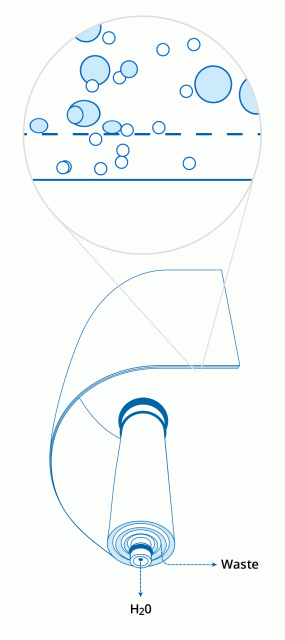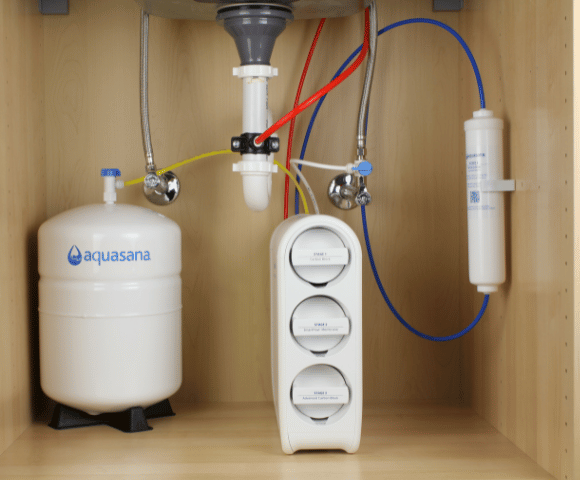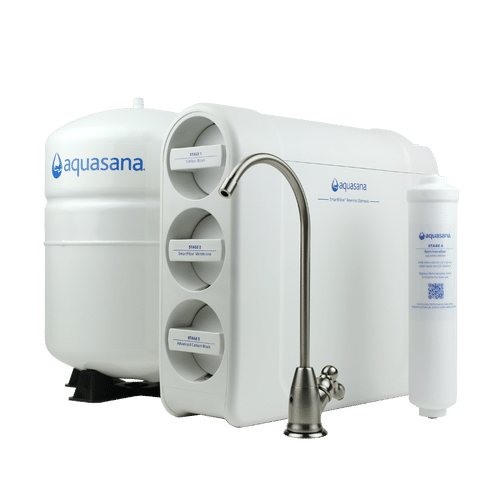How does reverse osmosis work?
To understand how reverse osmosis works, you first should understand the term ‘osmosis.’ According to Merriam Webster, osmosis is the “movement of a solvent (such as water) through a semi-permeable membrane into a solution of higher solute concentration that tends to equalize the concentrations of solute on the two sides of the membrane.”
Reverse osmosis is a unique type of water filtration system that uses a semi-permeable membrane to filter your water. This thin membrane is made up of pores that are small enough to pass clean, healthy water through while rejecting larger molecules that contain contaminants and impurities. When being filtered, the water moves from a high concentration to a lower concentration through the semi-permeable membrane with the help of external pressure. Reverse osmosis has mainly been used to produce purified water for industrial settings, like seawater desalination, but can now be used on the smaller scale to filter your home’s drinking water.
There are many benefits to using a Reverse Osmosis system in your home. If you’ve decided to make the switch, there is a little bit of upkeep with your RO system you should know. Doing so will provide you with a cleaner, more effective RO system, resulting in healthy, great-tasting water.
Why do reverse osmosis systems need maintenance?
Reverse osmosis systems filter out contaminants to improve your water quality, but those contaminants take a toll on the system which is why it’s necessary to replace components, sanitize the tank, and clean your connecting pipes from time-to-time. If you avoid these tasks, your system’s effectiveness will be reduced which means you won’t be as protected against contaminants. When your system is operating at its peak performance, it may have to work harder which can put strain on components and shorten the system’s lifespan. By spending a little time caring for your system, you can ensure it works properly and lasts for several years.
How to maintain your reverse osmosis system
Once you've made the switch to an RO system in your home, it's very important to stay on top of the system's maintenance. A high-quality RO system, like the SmartFlow® Reverse Osmosis, can filter your water for years if maintained properly. Here are a few tips to keep your system running smoothly and providing you with clean, healthy water.
1. Change your components on time
Our SmartFlow® Reverse Osmosis system features a Carbon Block, Advanced Carbon Block, SmartFlow® Membrane, and a Remineralizer. Changing these components on time is very important for maintaining performance, so you should stick to the recommended replacement schedules.
We make it easy to remember to replace your water filters with our Water for Life® program. Replacements are shipped directly to you, right when you need them, so you don’t have to worry about keeping up with filter expiration dates.

Carbon Block and Advanced Carbon Block
The Carbon Block acts as a pre-filter to reduce chlorine, off-taste, and unpleasant odor before the reverse osmosis process. Meanwhile the Advanced Carbon Block serves as a post-filter to address lead, microplastics, VOCs, and more after reverse osmosis has taken place.
We recommend replacing these components every 6 months, but you may need to replace them more often with high water usage or sediment level. As these blocks build up with sediment, you may notice a slower water output.
The Carbon Block and Advanced Carbon Block have been designed to replace with ease. Prior to replacement, turn off the cold water valve under your sink and turn on the faucet to disperse any remaining water before turning off again. To remove the existing components, simply twist counterclockwise and pull out the blocks in stages one and three. Discard these components, and insert the new blocks with the handles vertically aligned before twisting clockwise and pushing the blocks in. Turn the cold water valve back on, check for leaks while the water tank refills, and turn on the faucet and let it run until water stops flowing. Turn off the faucet to let the water tank refill, then empty it again and repeat the process for a total of three cycles.
RO Membrane
The RO Membrane is the heart of the reverse osmosis system. The second step in the filtration process, the membrane separates the contaminants from the water molecules before entering the post-filter. The semi-permeable membrane is designed to allow water through but filter out the harmful contaminants. The schedule of changing your RO membrane will depend on the pH level and hardness of your city’s water. Most municipally treated water has a 7.0-7.5 pH. In this case, you would need to replace your RO membrane every 12 months. Higher pH shortens membrane life causing pin-hole leaks and would shorten membrane life.
Replace the RO Membrane following the same process as the Carbon Block and Advanced Carbon Block.
Reverse Osmosis Remineralizer
The Remineralizer restores healthy minerals that often get removed during the reverse osmosis process. Restoring these minerals improves the pH balance, alkalinity, and health benefits of the water. We recommend replacing the Remineralizer every 6 months, but as with the other components, you may need to adjust this based on your water quality and usage.
Follow the same pre- and post- replacement process for the Remineralizer as the other components, but to actually swap the unit you’ll need to push in the quick connect part attaching the blue tube to the top of the Remineralizer. Pull out the tube at the top, then repeat on the bottom and discard the old Remineralizer. Put the new Remineralizer in the bracket, then reconnect the tubing starting at the top and going down to the bottom.

2. Drain and sanitize the water tanks
Ideally, you should completely drain your RO storage tank about every 2 weeks. Draining your tank ensures that the water will remain fresh, as well as helping the reverse osmosis membrane maintain the pressure it needs to flush out impurities.
Not sure what to do with the leftover water? Use the excess water to water potted plants or your garden! The water is free of contaminants, so it won’t harm them.
The tank will need time to refill, so we suggest draining your storage tank before you go to bed or leave for work in the morning.
Sanitizing your tank does not need to be done as often as draining. We recommend sanitizing the storage tank about every 12 months to remove any lingering harmful bacteria. Your system can be sanitized with bleach.
- Shut off the water supply to your RO system.
- Open the water faucet and depressurize the system. Close your water faucet once the water stops running.
- Disconnect the yellow tubing from the yellow inlet port on the backside of the system manifold, labeled, ‘tank.’ Do so by pushing on the quick-connect fitting while pulling the tubing out of the port.
- Then, pour 3mL of bleach into the open end of the yellow tubing.
- Reconnect the open end of the yellow tubing to the backside of the system manifold, labeled, ‘tank.’
- Next, turn on the water. Allow the system to fill up with water. Flush the system 2 times.
3. Cleanse and reassemble plumbing pipes
Cleaning your kitchen pipes is an important part of your home maintenance, with or without a RO system. Set a regular maintenance routine for a couple times a year to keep your kitchen pipes clog-free. Cleaning your pipes doesn't take much time and it's a task you can easily do yourself. Flushing your drain with salt and hot water is a simple way to combat grease and soap build up in your kitchen pipes. The hot water melts the buildup while the salt acts as a natural scouring agent to remove the grime.
Purchasing a reverse osmosis system can seem like a big commitment. But when you're committing to healthy, clean water for your family, it pays off. Following these simple tips to maintain your RO system will keep your filter in great shape to last you for many years.
If you're currently looking at purchasing a Reverse Osmosis system that will last for years to come, consider Aquasana's SmartFlow® Reverse Osmosis water filter. This filter utilizes reverse osmosis to remove 99.99% of 90 contaminants including lead, arsenic, chlorine, and fluoride among others. While some Reverse Osmosis systems remove healthy minerals including calcium in the process, our system utilizes remineralization technology to retain these ensuring you get all the benefits of your filtered water.
UNDER SINK WATER FILTER
SmartFlow® Reverse Osmosis
High-efficiency reverse osmosis system removes up to 99.99% of 90 contaminants, including fluoride, arsenic, chlorine, and lead.



